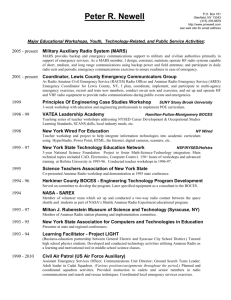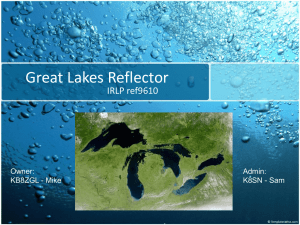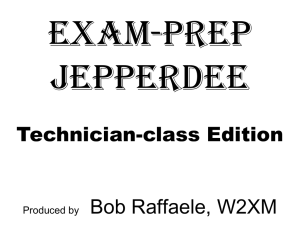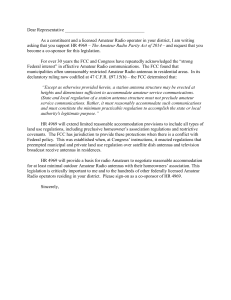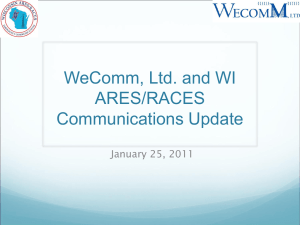IRLP Presentation - Jamaica Amateur Radio Association
advertisement
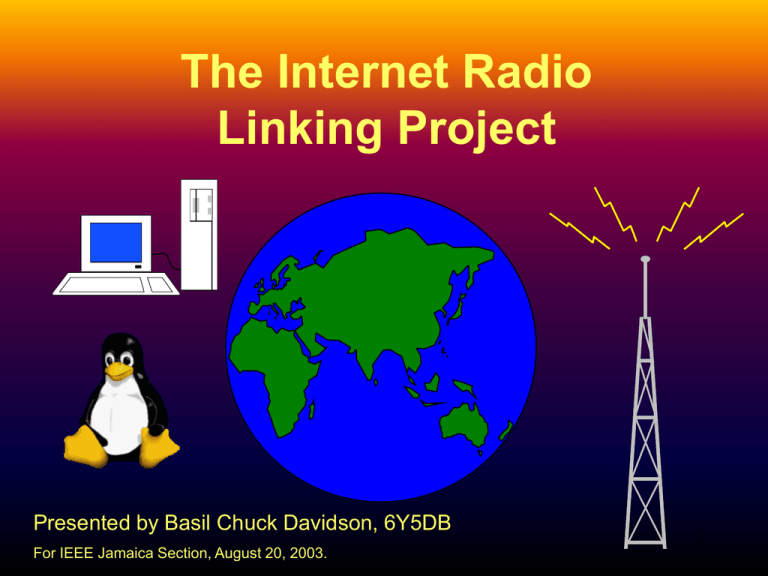
The Internet Radio Linking Project Presented by Basil Chuck Davidson, 6Y5DB For IEEE Jamaica Section, August 20, 2003. 1 Topics of Discussion • • • • • • Introduction Jamaica Amateur Radio Association What is Amateur Radio (ham radio)? Traditional Amateur Activities IT and Amateur Radio The Internet Radio Linking Project – What it is and its impact on Amateur Radio. – – – – – – • • • • How it works Typical IRLP Node Scripting Security Reflectors Impact and the Future How to become a Radio Amateur More Information – WWW sites to follow up. Demonstration of IRLP Thank You 2 Jamaica Amateur Radio Association (JARA) • Club station at Jamaica Red Cross (St Andrew) • Under 100 members in Jamaica, active in the following areas: – – – – Internet Radio Linking (IRLP) Satellites Education and Publicity Mobile and Portable Operation 3 What is Amateur Radio? • Amateur Radio stations are operated for the purposes of self training in radiocommunications, intercommunication using radiocommunications and technical investigation into radiocommunications by persons who: – do so solely with a personal aim; – have no pecuniary interest in the outcome of the operation of the station; and – are operated on [specified] amateur frequencies or frequency bands... 4 Traditional Amateur Activities • • • • • • • • • HF (Shortwave) communication Morse code Analog Voice VHF/UHF repeaters Satellite for ‘hams’ Radio Teletype + Packet switching Homebrewing (construction) “Dxing” (long distance contacts) Moon bounce transmission 5 IT and Amateur Radio • Computer Controlled Modes – Packet Radio – Slow Scan TV – Narrow Band Teletype (PSK-31, etc) • • • • • Digital Signal Processing Internet Radio Linking Remote Bases and Web Radios Internet Collaboration Publicity 6 The Internet Radio Linking Project (IRLP) • Uses the Internet to link distant radio sites together using VoIP. • Gives global coverage to normally localised VHF and UHF frequencies. • Enables minimally equipped stations to communicate globally. • Allows end user control of links via their radio’s DTMF (Touchtone) keypad. 7 How Internet Linking Works Mobile Station Radio Link IRLP Node Internet Distant Repeater Repeater IRLP Node The Internet is used as a link 8 to connect distant repeaters together Typical IRLP Node • • • • • • • Standard PC compatible is usually used. Pentium P100 or faster. Linux operating system (Red Hat). Soundcard and appropriate drivers. Simple hardware interface to control link radio. Radio tuned to the appropriate link frequency. ISDN/xDSL/cable/broadband Internet connection. 9 IRLP Scripting • The IRLP software is composed largely of bash shell scripts. • Easily customised to suit local needs. • Many functions and applications have been created. – – – – Node status (link off/on and where linked to). Time of day (talking clock). Weather reports. Parrot (simplex) repeater. • Almost anything that can be run from the console can be controlled via radio if needed. 10 IRLP Security • Regulations prohibit unlicenced people using amateur bands. • IRLP links are only accessible by amateur stations within range of a node. No direct Internet access. • Internet links use PGP for authentication to minimise the risk of someone impersonating a node. • OpenSSH used for remote administration. • Linux packages updated automatically (autorpm). 11 IRLP Reflectors • Server that enables multiple nodes to be linked together into a network – number limited only by bandwidth. • Running a reflector requires very fast Internet access (32 kbps per connected node) to handle the multiple data streams. Most reflectors are hosted at Internet Service Providers who often donate the bandwidth. 12 Impact of IRLP on Amateur Radio and the Public • Level of amateur activity has increased dramatically. • Amateurs who have been inactive for a long time are coming back on the air. • Amateur Radio is becoming more appealing to today’s Internet oriented youth. • New opportunities for experimentation. – Global network to communicate with the ISS 13 The Future • Internet linking is already becoming commonplace – over 1,000 IRLP nodes on air. • Improvements in technology will improve performance of links. • IPV6 and multicast offer more flexible linking with less bandwidth. • Technology can be ported to high speed amateur microwave and satellite links. 14 How to Become a Radio Amateur • Radio amateurs are licenced by the SMA (Belmont Road), once they pass required examinations in Amateur regulations, radio theory and, Morse Code. • Examinations are conducted when arranged by the JARA. • JARA runs study courses for amateur theory, regulations, and morse code. • More information – Amateur information from the ACA • http://www.aca.gov.au/publications/info/amateur_suite.htm – Ron Bertrand’s online study course • http://www.radioelectronicschool.com/ 15 More Information • IRLP – http://www.irlp.net • The Shack of VK3JED – http://vk3jed.vk.irlp.net • Amateur Radio FAQ – http://members.ozemail.com.au/~andrewd/hamradio/hamfaq.html • Moorabbin & District Radio Club – http://www.mdrc.org.au • WIA Victoria - http://www.wiavic.org.au/ • Wireless Institute of Australia – http://www.wia.org.au 16 Demonstration of IRLP • Linking to Cayman and Trinidad. • A URL to listen to streaming audio from one of the reflectors is http://www.irlp.net and click on the link. 17 Thank You Chuck, 6Y5DB 18

